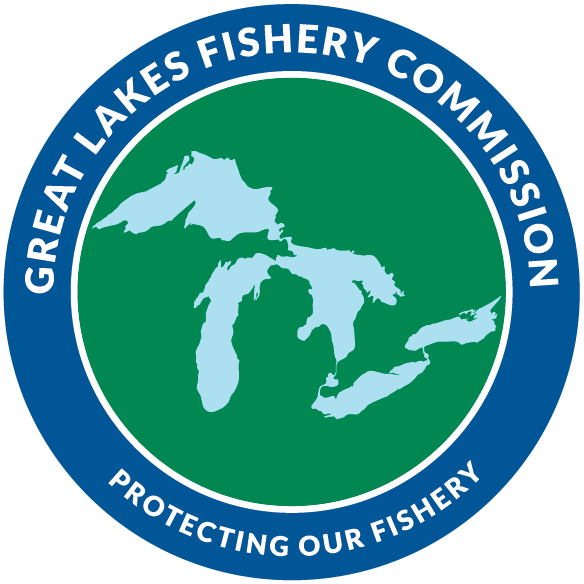Updated 2025-03-24 16:47:01
Lake Huron -> 1.0 Salmonine (Salmon and Trout) -> Wild Lake Trout Abundance
Reporting Interval
2018 - 2022
Area
lakewide
Meeting Target?
Does Not Meet
Indicator Trend
Upward trend
Confidence?
High
1.2.2 Relative abundance of wild Lake Trout
Continued wild recruitment that has resulted in the establishment of wild Lake Trout spawning stock in Michigan waters of Lake Huron. Abundance of wild juveniles in Michigan waters has increased slowly with only occasional strong year-classes (Figure 1). In contrast, abundance of wild adults in Michigan waters has increased rapidly due to a decline in mortality, which was 45% prior to 2000 but only 25% thereafter (Figure 1).
In Ontario waters, wild Lake Trout production has increased to an average juvenile catch-per-unit-effort (CPUE) of between 0.25 to 0.5 since the late-2000s (Figure 2). The recommended minimum target CPUE of wild juvenile Lake Trout is one individual per 305 m (1000 ft) of standard index gillnet (Ebener 1993). Measurable quantities of wild juvenile Lake Trout continue to be highest in the main basin, and recent signs of success also have been observed in the North Channel (Figure 2). In contrast, wild fish production in Georgian Bay appears to be declining (Figure 2). Throughout Ontario waters, the minimum threshold CPUE for wild juvenile lake trout has not been achieved for more than a single year (Figure 2).
Relative abundance of juvenile and adult wild Lake Trout, expressed as the number of fish caught per 305 m of gill net, during the annual spring gillnetting survey conducted by the Michigan Department of Natural Resources in Michigan waters of Lake Huron (depths: 10 to 60 m), 1970-2024.
Catch-per-unit-effort (CPUE) of wild juvenile Lake Trout per 305 m of standard index gillnet set in Ontario waters of Lake Huron (depth range: 10-60 m).
Methodology
Michigan waters: Linear mixed-effects models were used to assess the effects of area, month, depth and survey stations on Lake Trout catch rates. Adult mortality was estimated using linear mixed-effect models for catch-curve regression that estimated and separated individual year-class variation in determination of adult mortality.
Ontario waters: Data provided by the Upper Great Lakes Management Unit (UGLMU) of the Ontario Ministry of Natural Resources (MNR). Juvenile CPUE comes from the offshore index gillnet survey conducted in Ontario waters of Lake Huron. This survey is a spring-summer, multi-mesh fish community survey. Nets are 490 m long with mesh sizes from 32 to 153 mm (1.25” to 6”) which are set on bottom for approximately 24 hours. However, only six mesh sizes of 51 to 114 mm (2-4.75”) were used for the juveniles CPUE calculation. Sites are randomly selected both within and near historical commercial fishing locations.
All gillnetting surveys conducted by the UGLMU are made with monofilament. A total length of 532 mm (21 inches) was established as a cutoff to separate catches of juvenile and adult lake trout. Information reported herein are summarized using only means calculated arithmetically without any sample size cutoffs or outliers removed. Hatchery-reared (stocked/clipped) lake trout were identified based upon the presence of a fin clip, and lake trout without a fin clip were presumed wild. Age assignments are based off a combination of coded-wire tags, thin-sectioned otoliths, and fin clips.
Other Resources
Ebener, M. P. [ED.]. 1998. A lake trout rehabilitation guide for Lake Huron. Great Lakes Fishery Commission. 48 p.
He, J.X. 2024. Adult mortality and year-class strength of lake trout before and after alewife collapse in the main basin of Lake Huron. Journal of Great Lakes Research 50(5): 102397.
He, J.X., Bence, J.R., Madenjian, C.P., and Claramunt, R. 2020. Dynamics of lake trout production in the main basin of Lake Huron. ICES Journal of Marian Science 73: 975-987.
He, J.X., Ebener, M.P., Clark Jr., R.D., Bence, J.R., Madenjian, C.P., McDonnell, K.N., Kornis, M.S., and Bronte, C.R. 2022. Estimating catch curve mortality based on relative return rates of coded wire tagged lake trout in U.S. waters of Lake Huron. Canadian Journal of Fisheries and Aquatic Sciences 79: 601-610.
He, J.X., Madenjian, C.P., and Wills, T.C. 2023. A generalized application of the catch-curve regression with comparisons of adult mortality and year-class strength between hatchery-stocked and wild-reared lake trout in US waters of Lake Huron. Canadian Journal of Fisheries and Aquatic Sciences 80: 1714-1722.
Contributing Author(s)
- Ji He - Michigan Department of Natural Resources
- Jose Bonilla-Gomez & Scott Koproski - United States Fish and Wildlife Service
- Stephen James & Chris Davis - Ontario Ministry of Natural Resources

